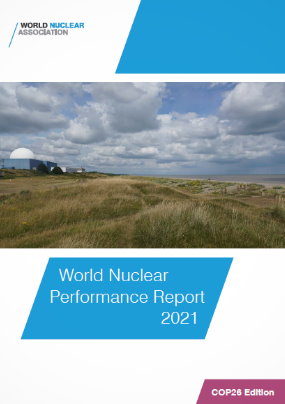Nuclear’s contribution to global climate change mitigation highlighted in new report
29 October 2021
The contribution nuclear generation makes to climate change mitigation is highlighted in a new edition of the World Nuclear Performance Report, produced by World Nuclear Association for COP26.
Nuclear reactors worldwide have helped avoid the emission of 72 billion tonnes of carbon dioxide over the last fifty years, compared to coal-fired electricity generation. This is more than twice the total amount of carbon dioxide emitted globally each year.
In the last ten years alone, if coal had been used to generate the same amount of electricity as has been supplied by nuclear power, there would have been an additional 20 billion tonnes of carbon dioxide emitted. This equivalent to the combined annual emissions of China, USA and India, the three countries with the highest CO2 emissions.
At the end of 2020 there were 441 operable nuclear reactors, with a combined capacity of 392 GWe. In total, nuclear reactors generated 2,553 TWh of electricity worldwide in 2020, just over 10% of global electricity supply.
The total capacity of operable nuclear power plants has remained almost constant for the last three years. Between 2018 and 2020 there were 20 reactors that started up, with a total capacity of 21.3 GWe. However, over the same period 26 reactors permanently shut down with a total capacity of 20.8 GWe. Commenting on this, Sama Bilbao y León, World Nuclear Association Director General said,
“More than half of the reactors permanently shut down in the last few years have done so not because of technical limitations, but because of political phaseout policies or the failure of markets to adequately recognize the value of on-demand, low-carbon, reliable nuclear power. This is a loss of low-carbon generation that the world can ill-afford to squander.
“It is vital that the contribution made by nuclear generation increases to help reduce greenhouse gas emissions from fossil fuels. In addition to its enormous contribution to low carbon electricity generation, nuclear energy can also produce low-carbon heat, which offers enormous opportunities to decarbonize other hard-to-abate sectors of the economy, such as hydrogen production, heating and cooling of buildings, industrial processes, fresh water production, transport and shipping. The operation of the existing nuclear fleet must be extended as long as feasible, and the pace and scale of new nuclear construction must increase.”
Notes for Editors
World Nuclear Performance Report 2021 COP26 Edition has been updated to report on CO2 emissions avoided in countries operating nuclear power plants. The report includes overall emissions avoided since 1970, and annual emissions avoided since 2016.
The report also includes analysis of the performance of reactors worldwide for both construction and operation, as well as the latest developments in each country currently operating and/or constructing nuclear reactors.
The report also includes four case studies highlighting the contribution of nuclear energy to climate change mitigation. These include:
- Grohnde, the German reactor that has produced more electricity than any other reactor,
- Haiyang, a reactor in China that is being used to supply both clean electricity and district heating,
- Akkuyu, the first nuclear power plant to be constructed in Turkey, and
- Peach Bottom, a US reactor that has applied to operate for 80 years.
The report is available to download now.
